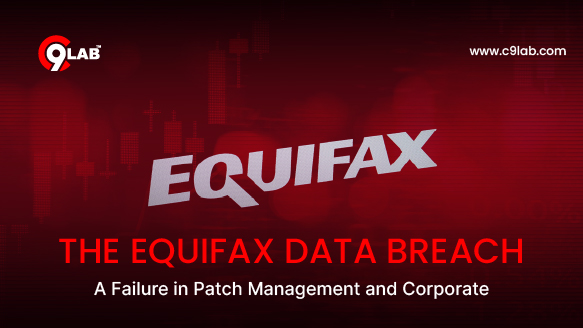Abstract
This case study examines the 2017 Equifax data breach, one of the most significant cybersecurity failures in history due to its scale and preventability. The report analyzes the cascade of organizational and technical failures that led to the exposure of sensitive personal data of 147 million individuals. The focus is on the critical vulnerability management lifecycle failure, compounded by inadequate asset management and internal security controls, and the resulting legal, financial, and regulatory repercussions that have reshaped corporate accountability for data protection.
Executive Summary
Equifax failed to patch a critical, publicly disclosed vulnerability (CVE-2017-5638) in the Apache Struts web framework on its online dispute portal. Attackers exploited this unpatched flaw over several months, exfiltrating the Personally Identifiable Information (PII) of 147 million consumers. The breach was a result of a systemic failure in patching procedures, ineffective vulnerability scanning, poor network segmentation, and a lack of fundamental security controls. The company incurred over $1.4 billion in fines and settlements, and the incident led to the resignation of key executives, serving as a stark lesson in the necessity of rigorous cyber hygiene.
Scope and Ethical Constraints
This analysis is based entirely on public records, including the U.S. Government Accountability Office (GAO) report, findings from the House Committee on Oversight and Government Reform, and public legal settlements.
Background (Why This Matters)
Equifax, as one of the three major credit bureaus, functions as a de facto keeper of citizen financial identity. The breach demonstrated that the failure to protect such a vast repository of sensitive PII is not merely an IT issue but a critical business failure with severe consequences for consumer trust and corporate viability.
Incident Summary
- Date of Detection: July 29, 2017
- Impacted Organization: Equifax Inc. (Financial Services / Data Aggregator)
- Initial Finding: Suspicious network traffic related to the online dispute portal.
- Primary Cause: Failure to patch a known critical vulnerability in Apache Struts.
- Impact: Theft of PII, including names, Social Security numbers, birth dates, and addresses for 147 million people.
Methodology — Analysis of a Cascading Failure
The breach resulted from a sequence of critical security failures.
- The Primary Failure (Unpatched Vulnerability):
- A patch for CVE-2017-5638 was released on March 7, 2017. US-CERT issued an alert on March 8.
- Critical Failure: Equifax’s IT team failed to deploy the patch to their online dispute portal system.
- Compounding Failures:
- Ineffective Asset Management: The company lacked a complete inventory of its internet-facing systems, leading to a lack of visibility.
- Failed Vulnerability Scanning: Security scanners were misconfigured and failed to detect the unpatched system.
- Poor Internal Controls: Attackers discovered plaintext credentials stored on servers, allowing easy lateral movement to over 50 databases.
- Blind Monitoring: A security certificate on a data monitoring system had expired, leaving exfiltration undetected for months.
Timeline
| UTC Timestamp | Event | Source/Evidence |
| Mar 7, 2017 | Apache Struts vulnerability (CVE-2017-5638) disclosed; patch released. | Apache Security Bulletin |
| Mar 8, 2017 | US-CERT issues alert urging immediate patching. | US-CERT Alert (TA17-075A) |
| Mar 9, 2017 | Equifax’s IT team sends an internal alert; patch is not applied. | House Committee Report |
| Mid-May 2017 | Attackers exploit the unpatched vulnerability and gain access. | GAO Report, Company Disclosure |
| July 29, 2017 | Equifax detects suspicious network traffic. Breach confirmed. | Company Timeline |
| Sep 7, 2017 | Equifax publicly announces the breach. | Public Announcement |
Findings
- Patch Management is a Core Business Function: For organizations handling critical data, timely patching of known vulnerabilities is a fundamental business imperative, not a secondary IT task.
- You Cannot Protect What You Don’t Know: The lack of a comprehensive and accurate IT asset inventory was a foundational failure that prevented effective defense.
- Security as a Board-Level Issue: The breach proved that cybersecurity negligence leads to direct executive accountability, massive financial penalties, and reputational devastation.
- Encryption and Credential Management are Essential: Storing sensitive data and system credentials in plaintext is an unforgivable failure in modern security architecture.
Remediation Steps Taken (Summary)
- Complete overhaul of IT and security leadership.
- Implementation of an enterprise-wide patch management and vulnerability remediation program.
- Investment in enhanced asset discovery and management tools.
- Agreement to a global settlement with the FTC, CFPB, and states, including a fund of up to $700 million to compensate consumers.
Recommendations (For Data-Centric Organizations)
- Establish a Rigorous Patch Management Cycle: Mandate and audit the deployment of critical patches within 48 hours of release.
- Maintain a Dynamic Asset Inventory: Continuously discover and categorize all internet-facing assets and their dependencies.
- Enforce Principle of Least Privilege and Encryption: Ensure robust access controls and encrypt all sensitive data at rest and in transit.
- Elevate Security Governance: Make cybersecurity a regular board-level agenda item with direct C-level accountability.
Conclusion
The Equifax breach stands as a landmark case of corporate cybersecurity failure. It was not the result of a novel threat but of the neglect of basic cybersecurity disciplines. It permanently redefined the cost of poor cyber hygiene and established a new benchmark for regulatory and financial consequences, making it one of the most expensive lessons in the history of information security.

